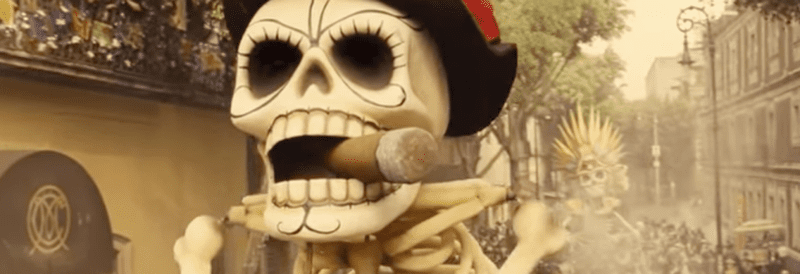Mexico City’s Day of the Dead Parade Invented By the James Bond film SPECTRE
Eight minutes in SPECTRE changed Mexico City’s celebration of the Day of the Dead. For almost ten years, the city has commemorated the Day of the Dead with a parade inspired by Daniel Craig’s fourth Bond film–a parade that never existed before.
The fictitious parade in SPECTRE features crowds of Mexican citizens, dressed like skeletons, who dance and party in Zócalo, the city’s main square, and surrounding streets.
Emerging from the crowd in his own skull and skeleton costumed disguise, Bond thwarts a planned terrorist attack, and pursues ringleader Marco Sciarra, an Italian mafioso working for SPECTRE. The foot chase through the parade leads to a spectacular fight to the death on board an out-of-control helicopter.
Sam Mendes, directing his second Bond film, based the skull iconography of the parade, including a giant float with a skull wearing a top hat, on Live and Let Die. The top hat is a reference to Baron Samedi, a supernatural being from Haitian voodoo, who features as an unkillable henchman in Live and Let Die.
Baron Samedi’s float, which is the opening shot of SPECTRE, presents the character in his traditional representation as a cigar-smoking skull wearing a black hat.
Though he has nothing to do with Mexican culture, the first real Day of the Dead parade in Mexico featured a float of Samedi that is a near perfect copy of the float in the film SPECTRE.
Mexico City; October 16 2016, Giant float at Day of the Dead Parade. Photo credit: mure3496 / shutterstock.com
Is this life imitating art or what’s called the pizza effect?
The Pizza Effect: When Pop Culture Becomes Real Culture
The pizza effect refers to a cultural phenomenon exported to another culture where it is reintroduced in a modified form as part of their own culture.
The introduction of the Haitian Baron Samedi into a Mexican parade, which itself is based on a Bond film, fits the description of the pizza effect. And this remains the power of the Bond movie series on culture today, decades after the first film, Dr. No, released.
Daniel Craig and Mexican actress Stephanie Sigman in costume. Image credit: Sony Pictures via MovieStillsDB.com
Mendes favorite Bond film is Live and Let Die, but other than making a visual nod to the 1973 Bond film in the Day of the Dead parade, the festival’s celebrations are important to the plot of SPECTRE:
“One of the things that’s said about the Day of the Dead celebrations is that ‘los muertos vivos están’ – ‘The dead are alive.’ That has a direct bearing on our story.”
Indeed, Bond will discover a man from his past–previously believed dead–is alive and the “author of all Bond’s pain.”
Mendes, with his great sense of visual style, had no clue that the parade he created for SPECTRE’s opening scene would itself inspire a real Day of the Dead parade in Mexico City.
Many traditions for the Day of the Dead exist in Mexico City, but none featured a parade until a year after SPECTRE.
Mexican Authorities Pitched For Mexico City to Become a “Bond City”
According to leaked documents, Mexican officials offered Sony Pictures millions of dollars in tax incentives to be included as a location in the Bond film. Sony Pictures let Mexican authorities make changes to the script, including giving Mexican actress, Stephanie Sigman, the role as the opening sequence’s “Bond Girl” and changing the villains’ nationalities from Mexican to Italian.
Featuring your city in a Bond movie causes a considerable rise in tourism, even if it’s a well-known destination like Mexico City. Audiences watching SPECTRE wondered if the Day of the Dead parade was real. Mexico City made sure it was.
But before the parade became a central part of Mexico’s “Season of the Dead”, which runs from October 29 to November 2, citizens and especially local business owners were angry at the disturbance brought by the Bond film crew.
Zocalo, or Constitution Plaza, is the main square in Mexico City, the centre of the Day of the Dead parade and the location of Bond’s helicopter fight. Photo credit: Wikipedia
A significant area in Mexico City’s historic downtown were closed for filming over 10 days in March 2015. This week and a half cost 6,500 local businesses over 60% of their revenue, a collective loss of at least 375 million pesos (about $20 million dollars at the time).
But Mexico City Tourism Secretary Miguel Torruco Marqués, who helped get the deal with Sony, assured angry business owners that the revenue lost from traffic problems and closures would result in even more tourism dollars once Mexico City was dubbed a “Bond City.”
“Bond Cities start booming as soon as the movie comes out,” Torruco Marqués told reporters at a press conference on April 1, 2015. “Not only in tourism, but also in investment. There will be a huge economic boom, and it will make up for the inconveniences.”
Mexico City’s First Day of the Dead Parade
Mexico’s tourist authorities were worried that tourists would come to Mexico City expecting the parade, and so made a similar parade of their own.
The first ever Day of the Dead parade in Mexico City launched on October 29, 2016, almost a year after the release of SPECTRE. Over a thousand participants, including choreographers, dancers, visual artists, and dozens of floats and giant sculptures were included.
Mexican authorities openly referred to it as a “SPECTRE-style parade” in press communications, but also added their own influences from Mexico’s rich cultural history, including the tradition of la Muerte Niña, the mostly obsolete practice of making portraits—first oil paintings, later photographs—with recently-deceased children dressed up in extravagant clothing, sometimes as angels with heavenly crowns.
At the time, Torruco Marqués hoped Mexico City’s Day of the Dead parade would compete with the Rio de Janeiro Carnival as the world’s biggest parade. The Rio de Janeiro Carnival also featured in a James Bond movie (Moonraker) as part of a chase.
The first parade in 2016 earned an estimated billion pesos (approx. $50 million) for Mexico City businesses related to the parade and the Formula 1 Grand Prix, which occurred on the same dates. Mexico City government officials estimated that 425,000 people lined the streets from the Angel of Independence to the Zócalo.
Some Mexicans Don’t Want the Parade
Plenty of Mexicans don’t agree with the festival, but have little impact on disrupting the Day of the Dead parade. Claudio Lomnitz, a professor of Mexican studies at Columbia University, criticized the parade in La Jornada in 2016:
“There’s an element of what we could call ‘national-narcissism,’ of a national imaginary in love with its own image, reflected in the mirror of Hollywood.”
The Day of the Dead parade has become a big draw for Mexican citizens and foreign tourists alike. While the Bond films have huge cultural impact, the parade will take on a life of its own and its origin will fade from memory and be viewed as a legitimate Mexican celebration.

